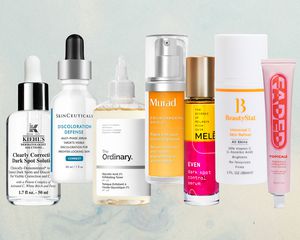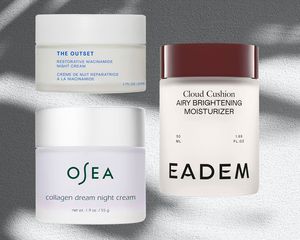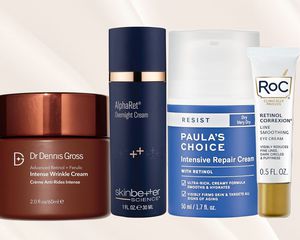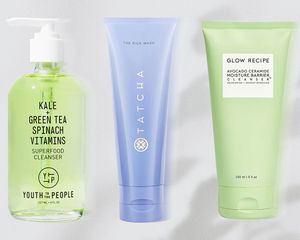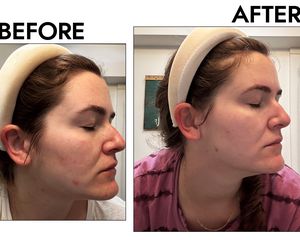:max_bytes(150000):strip_icc()/licoriceextract-d0a5322633934bdc953aecce64ceedac.png)
Stocksy
Looking for a way to achieve your bright, glowy skin goals without a pricey trip to the dermatologist? Allow us to introduce you to licorice extract. This powerhouse ingredient brightens like professional grade (and slightly problematic) hydroquinone, but without the serious drawbacks or $$$. Ready to learn all there is to know about licorice extract for your skin? We've tapped dermatologists, Rita Linkner and Jennifer Chwalek to give us the breakdown.
Meet the Expert
- Rita Linkner, MD, is a board-certified dermatologist and the founder of RVL Skincare, PC, her concierge care cosmetic dermatology practice.
- Jennifer Chwalek, MD is a board-certified dermatologist. She practices out of Union Square Laser Dermatology in New York City.
What Is Licorice Extract?
Like the sweet treat, it all comes back to the licorice plant (scientific term: Glycyrrhiza glabra...we'll just call it the licorice plant). The root of the plant has been used for medicinal purposes for years and is where black licorice the candy comes from, but it's also the source of licorice extract used topically for skin. This extract is filled with a variety of beneficial compounds, which do everything from delivering antioxidant and anti-inflammatory effects to help fade dark spots. It's the latter that makes it a choice ingredient in many skin-brightening products. It even acts similarly to hydroquinone (more on that in a minute), considered to be the gold-standard brightening ingredient, though notorious for its unwanted side effects and even potential safety concerns.
Licorice Extract
Type of ingredient: Skin brightener
Main benefits: Inhibits the production of an enzyme needed to produce melanin (pigment) in the skin, helps remove excess melanin, has anti-inflammatory benefits.
Who should use it: Anyone looking to reap the spot-fading, skin tone-evening benefits, as well as those looking to soothe irritated skin. Do not use if pregnant.
How often can you use it: This largely depends on the particular product formulation, but in most cases, once or twice a day, maximum, says Dr. Chwalek.
Works well with: Because of its main benefits, it's often mixed with other antioxidants and skin brighteners, such as niacinamide and vitamin C.
Don't use with: Because it does have the potential to be somewhat irritating, Dr. Linkner advises not using it in conjunction with retinol and/or hydroquinone.
Benefits of Licorice Extract For Skin
- Minimizes the production of tyrosinase to combat discoloration: The production of melanin (AKA pigment or color) is a complicated process, but at the heart of the matter is an enzyme known as tyrosinase. Licorice extract inhibits the production of tyrosinase, in turn inhibiting the production of dark spots.
- Removes excess melanin: Licorice extract brightens the skin in another way, too. "It contains liquiritin, an active compound that helps to disperse and remove existing melanin in the skin," explains Dr. Chwalek. In other words, not only can it help prevent new spots from forming, but it can also fade existing ones.
- Acts as a potent antioxidant: Like many other plant-based extracts, licorice contains a flavonoid, an antioxidant-rich component that decreases reactive oxygen species, which both age and discolor the skin, says Dr. Linkner.
- Offers anti-inflammatory benefits: While the flavonoid is anti-inflammatory itself, there's yet another molecule, licochalcone A, which inhibits two inflammatory markers that trigger the inflammatory cascade, Dr. Chwalek says.
- May help control oil production in the skin: Though this isn't one of the more commonly agreed upon benefits, Dr. Chwalek says that there's some evidence to suggest that the licochalcone compound may have the added benefit of regulating oil production. It may even be why licorice extract is often used in Ayurvedic medicine as a dandruff treatment.
Side Effects of Licorice Extract
While this is a rare allergen– meaning it's unlikely to cause an actual allergy– depending on what other ingredients licorice extract is mixed with, it can sometimes cause a reaction, notes Dr. Chwalek. Dr. Linkner adds that some people, especially those with sensitive skin could experience irritation. As a general rule, if you're concerned about it stressing out your skin, try any new products out on a small test spot before applying all over your face.
How to Use It
Like other spot-faders, it's a good idea to look for this in a serum, which will be more concentrated and contain higher amounts of the ingredient. Per the point about it being potentially irritating, be sure to follow exact product directions when it comes to how often and when to use it. And, while it should go without saying, be extra diligent about sun protection and daily SPF when using licorice extract (or any ingredient targeting hyperpigmentation). Sun exposure may counteract and thwart any of your skin-brightening efforts.
We like Topicals Faded Serum for Dark Spots & Discoloration. Along with licorice root, this product also contains other high-powered skin-brightening ingredients like niacinamide, azelaic acid, and tranexamic acid. Shea butter gives it a rich, hydrating texture that's great for dry skin, and centella asiatica helps calm inflammation.

